
The peach is a deciduous tree first domesticated and cultivated in China. It bears edible juicy fruits with various characteristics, most called peaches and the glossy-skinned, non-fuzzy varieties called nectarines.

A cherry is the fruit of many plants of the genus Prunus, and is a fleshy drupe.

An apricot is a fruit, or the tree that bears the fruit, of several species in the genus Prunus.

A plum is a fruit of some species in Prunus subg. Prunus. Dried plums are often called prunes, though in the United States they may be labeled as 'dried plums', especially during the 21st century.

Prunus is a genus of flowering trees and shrubs from the family Rosaceae, which includes plums, cherries, peaches, nectarines, apricots and almonds. The genus has a cosmopolitan distribution, being native to the temperate regions of North America, the neotropics of South America, and temperate and tropical regions of Eurasia and Africa, There are about 340 accepted species as of March 2024.
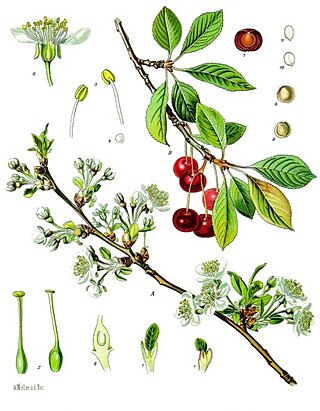
Prunus cerasus is an Old World species of Prunus in the subgenus Cerasus (cherries). It has two main groups of cultivars: the dark-red Morello cherry and the lighter-red Amarelle cherry. The sour pulp is edible.

The cherry blossom, or sakura, is the flower of trees in Prunus subgenus Cerasus. Sakura usually refers to flowers of ornamental cherry trees, such as cultivars of Prunus serrulata, not trees grown for their fruit. Cherry blossoms have been described as having a vanilla-like smell, which is mainly attributed to coumarin.

Prunus spinosa, called blackthorn or sloe, is an Old World species of flowering plant in the rose family, Rosaceae. It is locally naturalized in parts of the New World.

Prunus armeniaca is the most commonly cultivated apricot species. The native range is somewhat uncertain due to its extensive prehistoric cultivation. Genetic studies indicate Central Asia is the center of origin. It is extensively cultivated in many countries and has escaped into the wild in many places.

Prunus padus, known as bird cherry, hackberry, hagberry, or Mayday tree, is a flowering plant in the rose family. It is a species of cherry, a deciduous small tree or large shrub up to 16 metres (52 ft) tall. It is the type species of the subgenus Padus, which have flowers in racemes. It is native to northern Europe and northern and northeast Asia, and is grown as an ornamental in North America.

Prunus serrulata or Japanese cherry is a species of cherry tree that grows naturally in Japan, China, Korea, Vietnam, Taiwan, Laos, Myanmar, Thailand, Cambodia, India, Bangladesh, Bhutan, Nepal, Sri Lanka, Pakistan, Philippines, Malaysia, Indonesia, Brunei, Mongolia, Siberia, Papua New Guinea and into the Cape York Peninsula in north Queensland (Australia). The term also refers to a cultivar produced from Prunus speciosa, a cherry tree endemic in Japan. Historically, the Japanese have developed many cultivars by selective breeding of cherry trees, which are produced by the complicated crossing of several wild species, and they are used for ornamental purposes all over the world. Of these, the cultivars produced by complex interspecific hybrids based on the Oshima cherry are also known as the Cerasus Sato-zakura Group.

Prunus serotina, commonly called black cherry, wild black cherry, rum cherry, or mountain black cherry, is a deciduous tree or shrub in the rose family Rosaceae. Despite its common names, it is not very closely related to commonly cultivated cherries. It is found in the Americas.
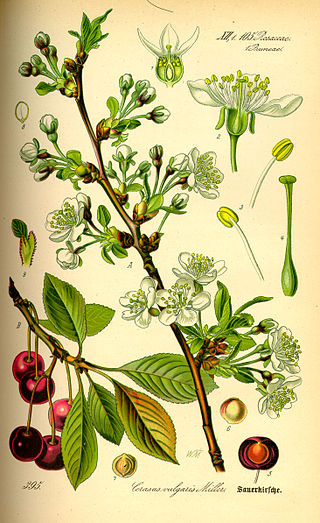
The marasca cherry is a type of sour Morello cherry known only from cultivation. It is reputed to attain its finest flavor when grown in coastal Croatia.
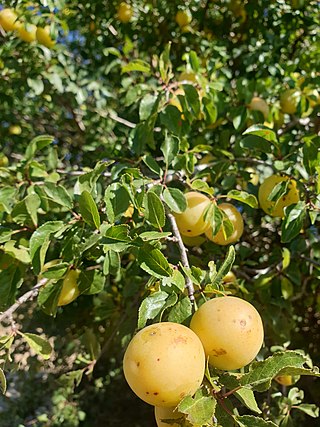
Prunus cocomilia is a species of plum commonly called Italian plum. It is native to Albania, Croatia, Greece, southern Italy, Montenegro, North Macedonia, Serbia, and western Turkey.

Prunus domestica is a species of flowering plant in the family Rosaceae. A deciduous tree, it includes many varieties of the fruit trees known as plums in English, though not all plums belong to this species. The greengages and damsons also belong to subspecies of P. domestica.
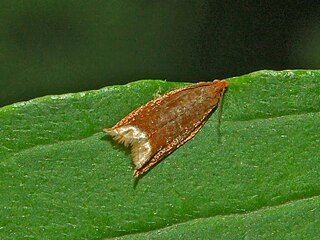
Ancylis selenana is a moth of the family Tortricidae. It is found from southern Sweden and Finland to France and Italy and to the Balkan Peninsula. Outside of Europe, it is found from Asia Minor to southern Siberia and Korea.
Ectoedemia mahalebella is a moth of the family Nepticulidae. It is found from the Czech Republic and Slovakia to the Pyrenees, Italy and Greece.

Prunus avium, commonly called wild cherry, sweet cherry or gean is a species of cherry, a flowering plant in the rose family, Rosaceae. It is native to Europe, Anatolia, Maghreb, and Western Asia, from the British Isles south to Morocco and Tunisia, north to the Trondheimsfjord region in Norway and east to the Caucasus and northern Iran, with a small isolated population in the western Himalaya. The species is widely cultivated in other regions and has become naturalized in North America, New Zealand and Australia.
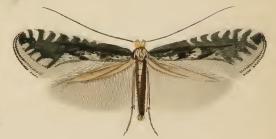
Parornix petiolella is a moth of the family Gracillariidae. It is known from Austria, Bulgaria, the Czech Republic, France, Germany, Hungary, Italy, Kazakhstan, Luxembourg, Moldova, Poland, Romania, the European part of Russia, Slovakia, Switzerland and Ukraine.

Coleophora prunifoliae is a moth of the family Coleophoridae. It is found from Scandinavia to the Pyrenees, Italy and Romania and from Great Britain to southern Russia.

















